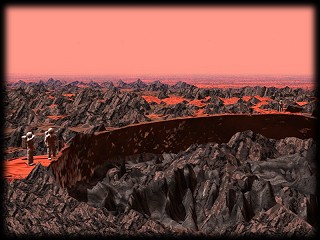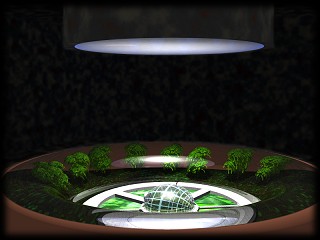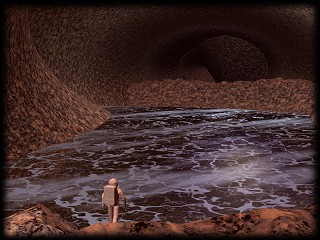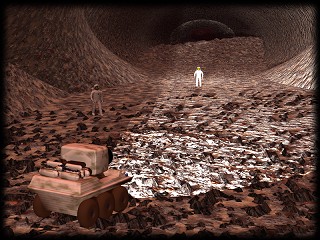
The Caves of Mars Educational Resources
Views of Pele Base
(Illustrations by G. Frederick)
 |
Lava Tube Sink Hole
The lava tube cave, in which Pele Base is constructed, was first discovered when a surface team investigated a large collapse sink along the northwest edge of the great scarp surrounding Olympus Mons. Like similar features on Earth, an opening was discovered that led into a large lava tube. Lava tubes are caves formed by flows of highly fluid lava--a "river" of molten rock flowing from an eruption source, either volcano or fissure. Often as the flow progresses, the tops and sides solidify. If the flow source stops, the remaining lava may pour out, leaving a hollow "tube" of rock. The collapse sink seen here happened shortly after the tube formed, and the lava started to solidify and contract. Weak sections fell in, proving to be, when observed from orbit, a handy indicator of the cave's location. |
Pele Base Light Pipe
Life underground will need light to survive. The thick lava ceiling provides us protection from the harsh surface conditions. It also blocks the life-giving energy from the sun, which we need to grow food for the colony, as well as run the biological systems that help clean our water and air. In the tube that forms Pele Base, we have features known as "hornitos." These are breaches in the solid roof of an active lava flow, which result in lava spattering out of the holes. The lava soon builds up a "spatter cone" around the opening, and can result in a "chimney" to the inner tube after the flow stops. Unlike a traditional skylight sinkhole, these openings do not have large rubble piles under them. Pele Cave has a number of hornitos in its ceiling, which allow for outside light to be "piped in" via inflatable, silvered mylar skylight tubes, to illuminate the interior. |
 |
 |
Underground Ice Rink
On Earth a "glaciere" is a type of cave, including lava tubes, that houses seasonal and sometimes permanent ice deposits. During the winter months, cold, sub-freezing air sinks into the cave's depths. Owing to the surrounding basalt's superior insulating properties, the air remains below the freezing point of water. When the spring thaw occurs, melt water trickling into the depths of the caves encounters this cold winter air and freezes out. On Mars, Pele Cave is just such a glaciere, as were many of the surrounding lava tubes along the great scarp. As the ancient Northern Ocean receded, water pooled in many of the lava tube caves and remained there as natural cisterns. As a result, Pele Base's water provides us with a series of layered snapshots of the past climates of Mars as well as our main export to other Martian colonies. |
Pele Base Explorations
As we continue to explore Pele Cave and other lava tubes in this area of the Red Planet, we continue to learn more about our new world, from the inside out. Making use of specially modified rovers and mobile habitat modules, we will explore deeper into the vast network of tubes that seem to honeycomb this area of Mars. Additionally, we make use of a self-deploying, self-optimizing, cellular network of insect robots, who will "colonize" a cave and become a line-of-sight communication system. Insect robots are capable of remarkably complex joint behavior, while the individual units only possess very simple behaviors. This system is a War-of-the-Worlds strategy in reverse, that is, sending armies of artificial bugs to Mars, not to conquer and destroy but to study and preserve. |
 |
 Project Home Project Home |